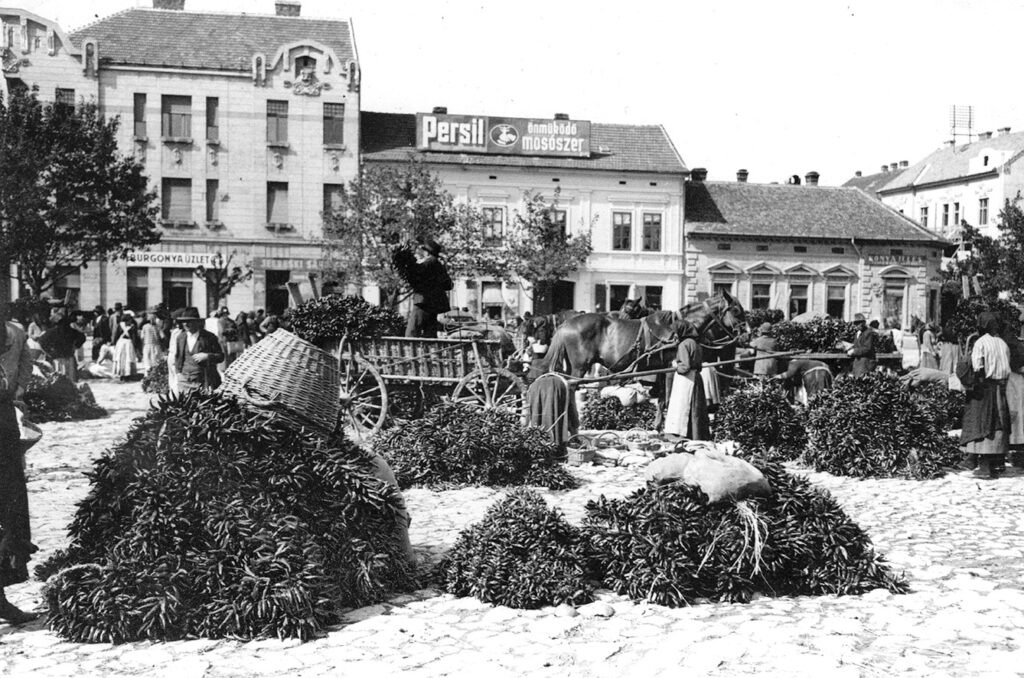When Cristopher Columbus first arrived in what he thought was a western part of India, the impact of his travel on the European economy and culture was immense. But as far as gold and gems played the main part in the economy, the culture and its foundations – like culinary art – were fueled by more modest means. Soon Italy was known as the land of tomatoes; eggplant became a staple in Greece, and chili peppers made their way deeper into the continent.
Paprika: a symbol of Hungary
Now peppers are a symbol of Hungary. Their colors are reflected (not on purpose) on the national flag; they are one of the most common motifs of the country’s souvenirs (fridge magnets in the shape of chili peppers abound in shops across the country). So yes, chili peppers really are a staple of Hungarian cuisine, adding richness, flavor, and spice to many traditional dishes.

Paprika, the English word for dried and ground peppers, refers to both the spice powder and the vegetable itself in Hungarian. But the origin of both words is the same: it comes from the name of the “original pepper,” the peppercorn. When Turks invaded Hungary in the 16th century, they brought paprika with them. Soon it was popularized – first appearing in aristocratic gardens – and came to be known as Turkish pepper.
And by the 18th century, it was already known as Hungarian pepper abroad and paprika domestically. One 18th-century source mentions the fruit, typical to the country, as being so spicy it could make you blind upon contact with your eyes. On the edge of the modern era, in the early 19th century, they were sold by cubic meter and not per piece, which shows their immense popularity.
And this combination of popularity and potent taste may be puzzling. One reason for the widespread popularity of chili peppers was that they were literally peppers for the poor. When paprika became popular, it soon was added to peasant meals in lieu of its more expensive peppercorn counterpart.
Feeling Hungary? Try paprika
This is how some of the most famous Hungarian meals came into existence, like goulash, whose name translates to “food for horsemen” and its thicker counterpart, pörkölt. There’s also a vegetarian version, called letcho, with assorted vegetables and pepper spice. And then, there’s paprika-spiced Mangalica sausage. Many more varieties appeared, and in the 19th century, as a part of the process of unifying nations, they were gradually labeled “traditional.”
Besides the obvious culinary appeal of paprika, it was also appreciated for its health benefits. In the 17th century, it was commonly used as a medicine. Purposes varied, from regulating blood pressure to healing colds to reducing fever. It was even used to fight cholera during the 1831 outbreak. Even today, it’s considered effective in some of those areas – especially blood issues.
Hungarians were accustomed to paprika’s heat. However, that was not the case in other countries. They realized that if they wanted to export paprika, it would need a little modification. They achieved this with the aid of the Pàlfy brothers, who, in 1859, invented a machine that would separate pepper pulp from the seeds, which allowed regulation of the amount of capsaicin, the chemical responsible for heat, in the final product.
The chili peppers glossary
The project succeeded, and soon, paprika was known in Vienna, and has now become a staple of Central Eastern European foods. It is believed that it was Auguste Escoffier himself, the inventor of modern gastronomy, who introduced paprika to Western foodways around 1879.
But, ubiquitous as it is now, paprika remains the symbol of Hungary. When browsing its varieties in Hungarian markets, remember the words:
- erös – means strong or potent. This is the spiciest paprika or chili pepper you can find here;
- csípős – means hot or strong in taste, and these peppers are decently high on the heat scale;
- csemege – means delicate, and these peppers have a kick but are relatively mild compared to the previous two. You might also see this word in combination with csípős – so csípős csemege paprika is milder than csípős, but spicier than csemege;
- különleges and édesnemes are among the mildest of them all.
Or just go for the fridge magnet. It surely won’t harm you.







